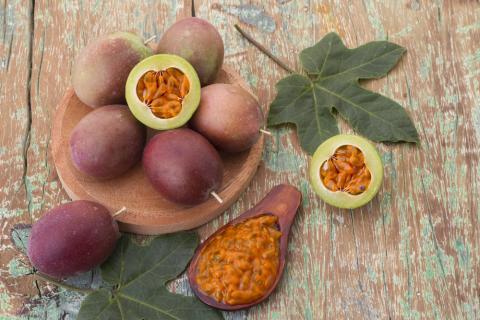
Gulupa is a member of the family Passifloraceae or Passion-flower family of the genus Passiflora L., commonly known as passionflower P, containing the species Passiflora edulis Sims or purple granadilla P. The plant is native to Brazil and flourishes in tropical America. It is also known as purple passion fruit, chulupa, and galupa culupo. It is rich in nutrients and is used as a healing herb and is an ingredient in many recipes. It is an attractive vining plant and is easily grown in gardens and does well as a container plant. Gulupa can be an irritant to those who have allergies to latex and while the flesh of the fruit is highly nutritious the skin is toxic, containing cyanogenic glycosides, and combined with the enzymes present in the skin form the poison cyanide; thus the skin is not edible and the fruit must be peeled before eating or used in recipes.
Gulupa has a smooth outer skin that is thick and is dark purple in color. Its flesh is yellow and juicy containing edible seeds and it has a mildly sweet, acid flavor with a pleasant scent. The plant can be found growing in the Andes mountain range at an elevation between 8,200 and 12,467 feet. It has a woody stem that vines up to forty-nine feet in length and its bark has a dark purple hue with stems that are a shade of white. The fruit is almost round and weighs about one-and-one-half ounces and grows to approximately two inches in diameter.
Health Benefits Of Gulupa
Though gulupa is small, it is packed with nutrients. Its vitamin content includes folates, niacin, pyridoxine, riboflavin, thiamin, and vitamins A, C, E, and K. The minerals found in gulupa are potassium, calcium, copper, iron, magnesium, phosphorus, selenium, and zinc. Other nutrients contained in the fruit include carotene-ß and crypto-xanthin-ß.
Gulupa has many health benefits that include the prevention of cancers due to its high content of antioxidants that heal cell damage due to naturally occurring free radicals. It is an excellent source of vitamin C, beta-carotene, and polyphenols which also aid in the protection against developing cancers. They are anti-inflammatory substances that prevent heart disease and help the body to maintain a healthy cardiovascular system.
Other health benefits of gulupa include its high vitamin A content, which is a major factor in ocular health and prevents degenerative eye diseases. It is also rich in fiber, which is essential for a healthy digestive system. Because gulupa is low in calories it is an ideal food for those on a weight loss diet.
How To Grow Gulupa
Growing gulupa is fairly easy and because it is a vine and a tropical plant it can be grown outdoors in warm climates and makes a decorative container plant for the colder climates, where it can be planted outdoors after the last frost. It can be planted from vine or seed in full sunlight and needs to be trellised for support of the vine. Use fertilizer made for flowering fruit and mulch the area to hold in the moisture. When growing gulupa in containers provide adequate size and support for the vines.
There are several types of gulupa, the purple variety of passion fruit. The Black Knight was developed in Massachusetts for potting and produces a fragrant, dark, purple-black fruit that is the size and shape of a large egg. The Edgehill originated in California and is similar to the Black Knight, only larger in size and does well outdoors. Another California variety is the Frederick, which is more oval and less purple in color and is slightly tart in flavor; it is used for juicing or can be eaten raw. The Purple Giant is, as its name implies, a very large fruit for the species.








